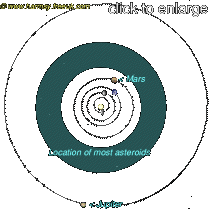
 |
Asteroids - planetary bricks |
|
| |
|

Fig. 1: Location of the asteroids There are probably over 10,000 asteroids larger than 100 km across in the Solar System, with many millions of smaller ones. Most of these can be found in a belt between the planets Mars and Jupiter. The first asteroid was discovered as a result of a curious relatonship known as Bode's Law. This is not a law at all, and is really only a coincidence. It goes as follows: Bode's Law
Now compare these values with the average distances of the planets (as known by Bode in 1772) from the Sun, measured in AU... |
The Hunt BeginsAlarmingly, Bode's Law produces numbers that are extremely close to the true values. But what was at 2.8 AU from the Sun? Surely something should be there, if all the planets fitted the series so well? A hunt was begun, and in 1801, Giuseppe Piazzi discovered what he thought was the missing planet at 2.76 AU from the Sun. It was named Ceres, but was only about 1000 km wide - hardly a planet. More were soon discovered in similar orbits, and they were named asteroids, meaning like stars. Near Earth AsteroidsThere are probably thousands of asteroids with orbits overlapping that of the Earth. NEAR (Near Earth Asteroid Rendezvous) is a NASA probe with a mission to find out more about them.Potentially Hazardous Asteroids (PHAs)We know of more than 375 PHAs that lie within 0·2 AU of Earth! NASA's Near-Earth Object (NEO) programme contains interactive features that allow the generation of tables of comet and asteroid positions and check for unknown objects in their fields of view.The NEO Website.
More Beyond Pluto?In 1992, similar objects to the asteroids were found way beyond the orbit of Pluto. These are the Kuiper Belt Objects.GCSE MaterialFind much more on asteroids on GCSE.com. | |||||||||||||||||||||||||||||||||||||||||||||
|
Sun | Mercury | Venus | Earth | Moon | Mars | Asteroids | Jupiter | Saturn | Uranus | Neptune | Pluto | X | Kuiper | ||||||||||||||||||||||||||||||||||||||||||||||